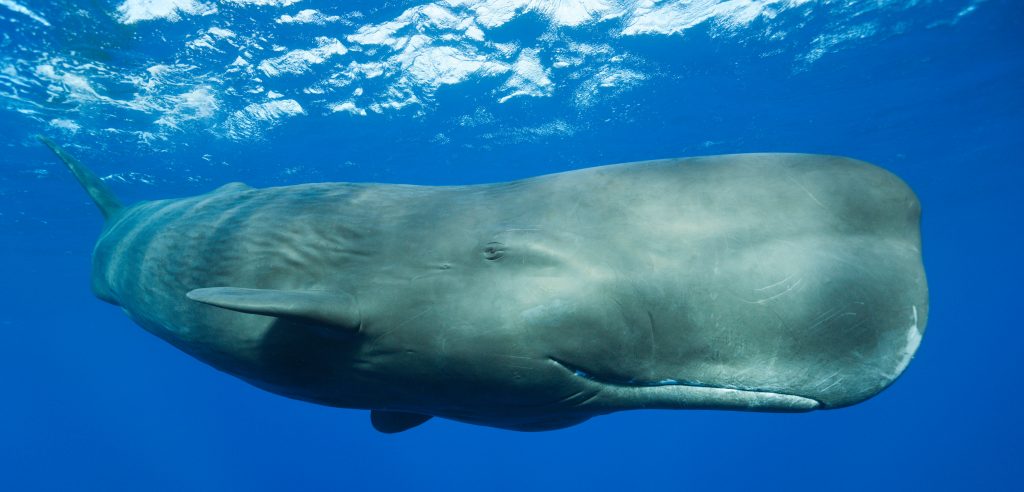This is the latest post in a series which will look at recent advancements, discoveries and trends in the study of whales and dolphins. We here at Sea Watch believe strongly in the free sharing and dissemination of scientific literature and want to give you, our loyal members, the breakdown of all that’s going on in the field.

Whaling is a tragic stain on our history which has, thankfully, come to an end in most parts of the world. The systematic exploitation of industrial whaling led to a constant and pressing demand for new populations of whales, which are then in their turn exploited. The patterns of the practice led first to the local eradication of the largest available species, followed by progressively smaller, and hence, less profitable whales (visualized in the graph below). One species was highly coveted not just for its remarkable size was the Sperm Whale. Found in all of the world’s oceans, these deep diving giants may now be best known for their underwater tussles with giant squid, but to the whalers of the 19th and 20th centuries, the sperm whales’ most compelling feature was its head full of valuable spermaceti oil (Whitehead 2018). A common sight on Victorians shelves, this clean burning oil was used to light candles, power early cars, and even protect metals from rust (Blakely & Rielly 1917) but originated in a specially evolved organ found in the sizable forehead of each sperm whale, known as the spermaceti organ (Evans 2020). The purpose of this organ divides scientific opinion, with many believing it to assist in the amplification of echolocation clicks, allowing the whale to hunt and navigate; and others believing the organ is key in regulating buoyancy during the sperm whale’s notoriously deep foraging dives (Evans, 2020; Whitehead 2018). Whatever the purpose, these massive organs can hold up to 1,900 litres of spermaceti oil, making even a single whale an incredibly valuable haul (Whitehead, 2018).
Like other toothed whales, of which they are the largest, sperm whales live in close knit social units consisting of 10-12 females and their immature young, mixing with other whales only within their own tropical breeding grounds (Best, 1979; Rendell & Whitehead 2003). Sperm whales have exceptionally large brains, and are capable of complex communication, which is pivotal in upholding these complex and variable social groups.
It is this combination of intelligence and communicative ability which has recently captured researchers’ attention. Digitized historical records from the logbooks of American whaling vessels in the 19th century reveal a startling pattern in the sperm whale hunt. Just a few short years after the expansion of the industry into the North Pacific the strike rate of whalers on sperm whales decreased dramatically (Whitehead et al., 2021).
Having modelled several theories as to why this may have happened, scientists believe sperm whales learnt how best to avoid whaling ships, and shared this information with other individuals through social learning. If the drop-off in strike rate were due to a decrease in efficiency by fishermen (an unlikely cause, given the constant advances in technology) then this pattern of decreased hit rate would have been mirrored in other areas and with other species, but this did not occur (Whitehead et al., 2021). Another theory is that the hunt initially killed off weak and susceptible individuals, leaving only those more adept at avoiding or surviving the whalers. This theory also seems unlikely, however, given how rapid and severe the drop in hit rate was. Circumstantial evidence from the handwritten notes of the whaling ships’ captains may shed further light on this fall in strike rate, with clues pointing to an increase in novel evasive behaviours by the whales (Whitehead et al., 2021) .
Sperm whales rarely need to concern themselves with the threat of predation, their only natural predator being killer whales (Whitehead, 2018), and while such predation events are rare, they have been documented and the defence strategies that sperm whales adopt may explain why whalers initially found it so easy to hit these giants. When under threat from predation from killer whales, the sperm whales huddle together at the surface, move slowly, and defend primarily with their tails (Pitman et al., 2001). Previously documented predation events describe sperm whales moving to break the circle only to defend an isolated individual (Pitman et al., 2001). Such behaviour must have been a whalers dream, as the slow moving perma-surfacing targets would make for easy aiming for the harpoon wielding fishermen.

Sperm whales began adopting a new behaviour, however, with whalers’ journals describing the great whales diving when in sight of the vessels, fleeing (especially upwind) and even attacking whaling ships (Whitehead et al., 2021), conjuring images of Captain Ahab and his great white foe. The veracity of such claims is questionable, the willingness or ability of a sperm whale to fully breach over a vessel seems doubtful. However, the mental impact caused by the perception of an increased difficulty in catching these ever more elusive goliaths, surely is linked to these tales of wiley and brave whales. While these stories may be exaggerated, there should be no doubt of the intelligence and adaptability of these deep diving behemoths.
Written by Jay Sea Watch Volunteer Feature Blogger
























